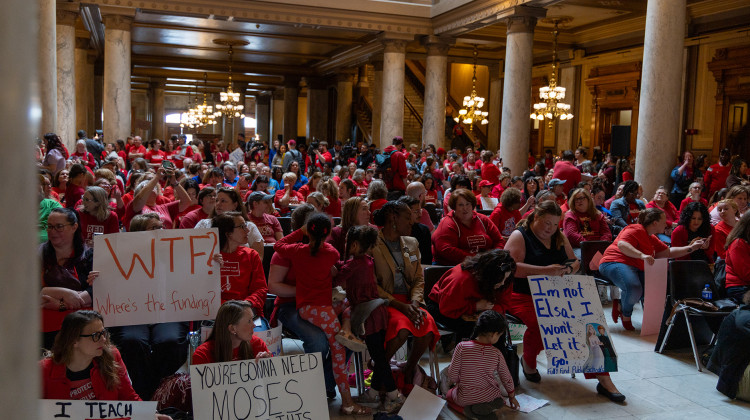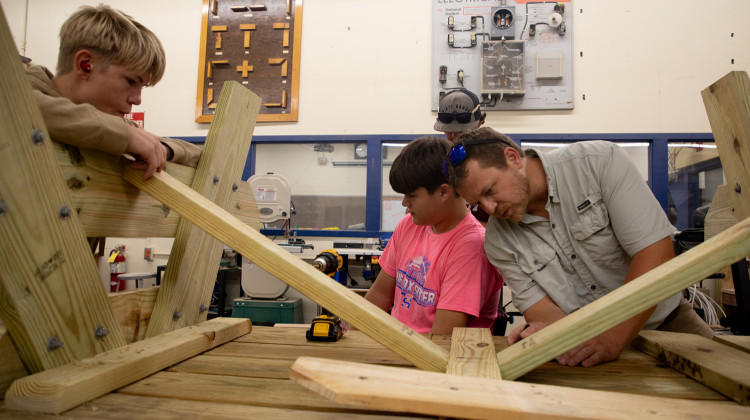
Indianapolis Public Schools struggles to recruit and retain teachers of color. Only 26 percent of IPS teachers identify as Black or Latino compared to 85 percent of the student population.
(Eric Weddle/WFYI)The majority of students at Indianapolis Public Schools are Black and Brown. Yet teachers of color make up less than 30 percent of educators.
It's a disparity the district has unsuccessfully tried to address in past years. Now, a new initiative announced Tuesday aims to improve the recruitment and retention of high-quality teachers of color through a paid residency.
The Proving What’s Possible initiative will provide a year-long program to help train and decrease barriers to entry for aspiring teachers and educators who want to become principals.
The district faces many challenges in recruiting, such as an ongoing national teacher shortage and the lack of appeal Indiana has for the small number of diverse educators graduating each year.
Andrea Rodriguez, who attended Meredith Nicholson School 96 as a youth, is hopeful the program will work. Last fall, she started teaching in the northwest side elementary school where nearly all students are children of color.
“My kids feel more represented with me being in the classroom,” she said. “They feel more confident in being able to talk to me, and coming up to me and just having conversations about things that they wouldn't be able to relate with, with another teacher.”
Research has shown a positive impact for Black and Brown students who are taught by a teacher of color. The classroom experience can lead to improved student attendance, academic achievement and an interest in post-secondary education. Research also found white students also benefit from diverse teachers.
“I want students to see that people that look like them can be teachers, can be professionals,” Rodriguez said. “I think a lot of them come from homes that don't have relatives that went to college and having somebody like me that did [go] to college – I can talk to them about that experience.”
“I know they're still young, but if you start talking to them from a younger age, it’s something that stays in their brain, and they can actually start thinking about it sooner.”
But IPS, like many school districts, has struggled to recruit and retain teachers for the past few years. Only 26 percent of IPS teachers identify as Black or Latino compared to 85 percent of the student population.
Recently, the district attracted more diverse candidates during the 2021-2022 hiring season. According to the district, 38 percent of IPS teaching applicants identified as a person of color during that time, which was twice as many from the previous year.
New teacher, principal training programs
The Proving What’s Possible initiative will launch this summer with two components — the IndyTeach Apprenticeship and the IPS Principal Residency.
The IndyTeach Apprenticeship is an educator training program that allows around 10 aspiring teachers to become embedded in a classroom. At the end of the program, participants will obtain an Indiana State Teaching License without returning to a university for an additional degree. Applicants must meet the initial criteria for licensure through the Indiana Department of Education.
Christel House Indianapolis, a local charter network and district innovation partner, will co-run the apprenticeship.
The IPS Principal Residency would be the only principal residency program in Indiana. It’s designed for assistant principals who want to become principals, current principals in other districts who want to join IPS and experienced educators.
IPS chief schools officer Nathalie Henderson said a similar program helped her.
“I am a graduate of a principal preparation program for a year, and I often credit that for my ability to have impacted student outcomes across systems in the country,” Henderson said.
The district is still determining how much participants will be paid for each program.
Federal pandemic funds will cover compensation.
National teacher shortage could pose challenges
Efforts to recruit and retain teachers, especially teachers of color, might not be easy.
Only about 10 percent of educators graduating from Indiana teacher prep programs identify as a person of color, said Alex Moseman, IPS director of talent acquisition. That makes hiring even more competitive as all school districts work to diversify their workforce.
“So if we looked across all districts in Indianapolis and you wanted to have parity between the percentage of students of color and the percentage of teachers of color, it would require roughly an additional 4,000 more teachers of color just in Indianapolis alone,” Moseman said. “Then you compare that to the roughly sort of 300 teachers of color who are coming out of teacher prep programs in Indiana statewide. There's a very big sort of gap within that.”
School districts across the country have struggled to fill positions this school year due to a national teacher shortage caused by the COVID-19 pandemic. Indiana is also facing a years-long shortage of special education teachers.
Although the district’s vacancies are within their normal projected range for this time period, Moseman said the district still has about 70 unfilled positions, which is slightly higher than last year.
“We are trending, at this point, pretty similar actually to where we were last year,” Moseman said. “We started to see resignation rates decline a little bit in this last month.”
IPS has worked to address this issue by increasing their teacher salary by 3 percent to remain competitive among other Marion County districts. Now the district claims it offers one of the highest teaching salaries in the central Indiana region at $50,000.
Contact WFYI education reporter Elizabeth Gabriel at egabriel@wfyi.org. Follow on Twitter: @_elizabethgabs.
 DONATE
DONATE






 Support WFYI. We can't do it without you.
Support WFYI. We can't do it without you.